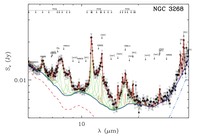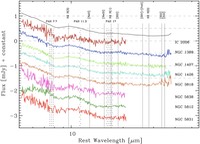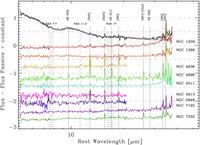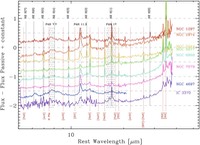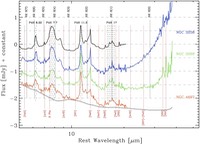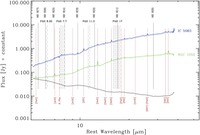Examples of the Spitzer-IRS spectra of our ETGs. Flux vs. rest wavelength obtained from low resolution modules. The LL modules have been scaled to SL fluxes.
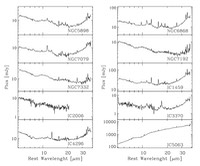
Emission lines are quite often observed in ETGs: about 75% show ionized gas in their inner part, independently of their luminosity, the presence of a bar and the environment richness (see e.g. Macchetto et al. 1996; Sarzi et al. 2006). On the grounds of the [NII 6583]/Ha line ratio, pioneering spectroscopic studies (Phillips et al. 1986) pointed out that the line emission in giant ETGs nuclei is ``indistinguishable'' from a low-ionization neclear emission-line regions (LINERs) (Heckman 1980).
Despite the huge quantity of studies, the nature of the ionizing mechanisms in LINERs is still controversial and debated. Recent studies in the optical domain suggest that more than one mechanism may be at work in LINERs, in particular in the nuclear region. From one side, Sarzi et al. (2010) showed that the role of AGN is confined to the central regions, whereas at larger radii the stellar and the nebular fluxes follow each other, thus suggesting a stellar ionizing source. From the other, Eracleous et al. (2010) showed that low accretion-rate AGNs do not produce enough ionizing photons to explain the observed Ha luminosities in nuclear regions, so that other mechanisms are needed.
In this context, we are analyzed the emission line properties of a sample of65 early-type galaxies (ETGs) in low density environments, selected as candidates for showing emission lines (see Annibali et al. 2010). Our optical spectra permits an analysis of emission lines up to half of the optical effective radius, re. After a proper subtraction of the underlying stellar population (Annibali et al. 2007), we find emission lines in the 89% of our sample, remaining (8 objects) are classified as inactive. Most of the active ETGs belong to the LINER class while basically the same percentage of emission lines displays transition properties, i.e. 10% HII/LINER class and 12% at the LINER/AGN class. Only IC 5063 has unambiguous Seyfert properties. The stronger nuclear (r<re/16) emission can be explained with photoionization by PAGB stars alone only for ~22% of the LINERs/Composite sample. On the other hand, we cannot exclude an important role of PAGB star photoionization at larger radii. Anyway, for the major fraction of the sample, the nuclear emission is consistent with excitation from a low-accretion rate AGN, fast shocks (200 -500 km/s) in a relatively gas poor environment (n<100 cm-3), or coexistence of the two. The derived [SII]6717/6731 ratios are consistent with the low gas densities required by the shock models.
Recently, Spitzer Space Telescope open the Mid-Infrared (MIR) window for the study of ETGs. Spitzer-IRS permits the identification of the characteristic spectra of passively evolving ETGs (see Bressan et al. 2006). Such spectra, devoid of Polycyclic Aromatic Hydrocarbons (PAH) features and characterized by the Si emission at 10 micron, are of crucial importance since they allow a proper subtraction of the stellar component from more active ETGs and consequently a correct determination of ionic and molecular lines and PAH intensities. Spitzer-IRS than opens a new diagnostic capability for the study of the gas excitation mechanisms from which to understand the relative contribution of AGN, shocks and stellar population to the energy of their line emission in LINERs.
The MIR diagnostic of a significant sample of LINERS exploiting Spitzer spectral capabilities has been performed by Sturm et al. (2006) (see also Rupke et al. 2007) and Dale et al. (2006). Sturm et al. (2006) compared the properties of two different LINER
populations: infrared-faint LINERS, with LINER emission arising mostly in compact
nuclear regions and infrared-luminous LINERS, which often show spatially extended (non AGN) LINER emission. They show that the two population of LINERs can be distinguished by their MIR spectral energy distribution (SED), using PAH and various combination of line ratios. IR-luminous LINERS show MIR SED typical of starburst galaxies. Rupke et al. (2007) suggest that IR-luminous LINERS have buried AGN with moderate-to-high ionization parameter and may contain strong Photo Dissociation Regions, while IR-faint LINERs have lower ionization parameter AGN and possibly strong X-ray Dissociation Regions. Dale et al. (2006) devised diagnostic diagram using both ionic lines and PAH emissions addressed to separate AGN from starburst generated emissions.
We present here the results of the homogeneous analysis of the Spitzer-IRS low resolution spectra of 40 ETGs, about 60% of the original sample of Annibali et al. (2007). The data set comes from our proprietary Spitzer-IRS observations (19 objects) and 21 additional ETGs, from the Spitzer archive. Nine of our ETGs are, indeed, in common with the Kaneda et al. (2008) and seven with Bregman et al. (2006) samples. The former authors concentrate their study on the origin and nature of the PAHs emission in ETGs, while the latter ones on the determination of the age of ETGs. We homogeneously extract the spectra and analyzed the emission lines and PAH properties. Measuring the fluxes of the atomic, molecular lines we aim at contributing to the characterization of the main mechanisms ionizing the gas in the nuclear region within these galaxies.
Main Results from the preliminary analysis
The Mid Infrared view of ETGs shows a variety of spectral characteristics. We empirically sub-divide the sample into five classes of spectra with common characteristics. Class-0, accounting for 20% of the sample, are purely passive ETGs with neither emission lines nor PAH features. Class-1 show emission lines but no PAH features, and account for 17.5% of the sample. Class-2, in which 50% of the ETGs are found, as well as having emission lines, show PAH features with unusual ratios, e.g. 7.7micron/11.3 micron< 2.3. Class-3 objects (7.5% of the sample) have emission lines and PAH features with ratios typical of star forming galaxies. Class-4, containing only 5% of the ETGs, is dominated by a hot dust continuum. The modeling of MIR diagnostic diagrams suggest that central emission line ratios for most of our ETGs, classified as LINERS using optical lines, are consistent with the presence of AGN and shock mechanisms or both. The proposed MIR spectral classes show unambiguously the manifold of the physical processes and ionization mechanisms, from star-formation, low level AGN activity, to shocks (H2), present in the LINER nuclei.
more details in
Panuzzo P., Rampazzo R., Bressan A., Vega O., Annibali F., Zeilinger W.W.
The SPITZER-IRS view of nearby-early-type galaxies with ionized gas:
Classification and powering mechanism of the ionized gas
2010, A&A, 528, A10.
